After working hard to make your lawn look lush and well-manicured, it’s unfortunate to see it all go to waste when weeds start invading the turf. Weeds are unwanted plants that plenty of lawn owners have to deal with. These pesky plants can easily invade a turf, especially those that prefer our warm and humid climate.
Aside from aesthetics, controlling and removing weeds is important to improve the health of your lawn. These pesky invaders may also steal nutrients from the grass, plants, and more. If they are not controlled, your lawn will become untidy, or worse, the grass and flowers may start to wither.
Before you start removing these out-of-place plants or start controlling them, you should first find out what you’re dealing with. You won’t be able to properly remove and prevent weeds in your yard if you don’t know what type it is. To help you out, here are some of the weeds that one may find in their Florida lawn.
In some cases you may want to contact a weed removal professional.
For that, we recommend using HomeAdvisor. Why? Simply put, they have a network of price competitive professionals that will compete for your business.
Savvy homeowners use this service to find better prices and service.
Read on, and submit a request at anytime. No obligations.
Dollarweed
One of the common types of weed you may find in your backyard is the dollarweed. Also called pennywort, this unwanted plant has round, glossy, and coin-shaped leaves, hence, the money connotations in its names.
Source: Missouri State University
It’s a small weed that is often confused with dichondra, but you can differentiate the two by checking the stems. The dollarweed’s stem is connected to the center of the leaf, while the dichondra’s stem is connected to the edge of the leaf.
Since dollarweeds have shiny leaves, some people think they’re pretty and often keep them. Which is fine, as long as they are under control since they can also be used as groundcover plants.
Goosegrass
Another troublesome weed you may find in your lawn is goosegrass. Also called crowfoot, wiregrass, or silver crabgrass, this is a leafy plant with reclining tufts that thrive during the warm season. They have a strong and extensive root system, so it can be quite difficult to get rid of them.
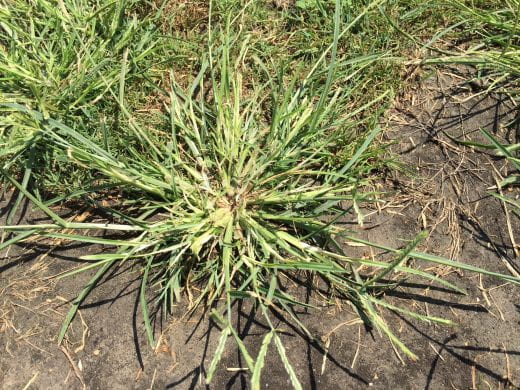
Source: Kansas State University
Unlike the glossy dollarweeds, this weed is unsightly, so you wouldn’t want it in your yard. To determine if you have goosegrass, check if the stems of the weed are whitish and flattened.
This pesky plant is typically found in thin areas of your turf, invading hard compacted soils, or areas with high traffic such as golf courses or fields. Once goosegrass becomes established in your lawn, expect to see them sprouting the following year. Be careful of this weed because if it grows on your lawn, it’s time to research how to cure diseases such as Sugar Cane Mosaic.
Dandelion
Before I owned a lawn, I thought dandelions were just beautiful flowers. They are still beautiful, but if they’re overcrowding the grass in your lawn, they become pretty but pesky invaders.
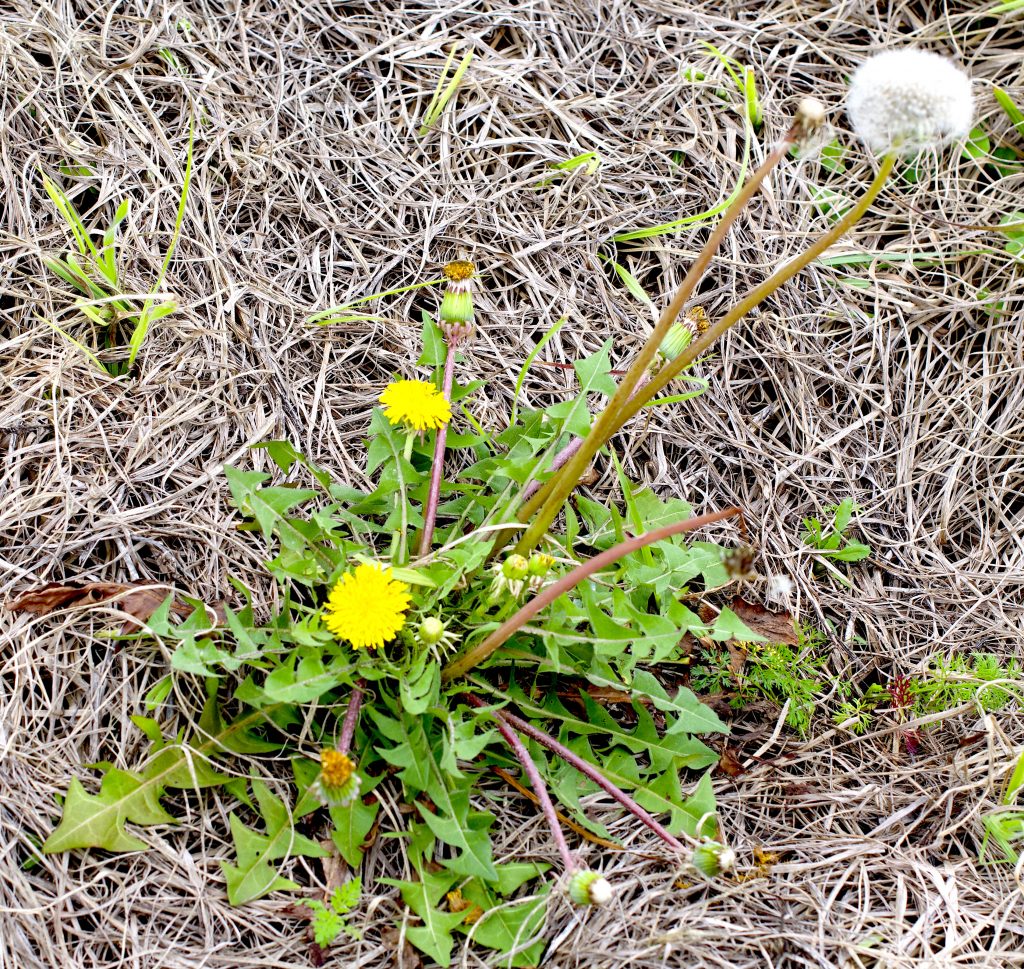
Source: Eat The Weeds (Green Deane)
This weed’s name means lion’s tooth in French since its leaves are said to resemble them, but some people also call it faceclock or blowball. They sometimes remind me of sunflowers because it has yellow flowers, but they won’t be confused for one another because dandelions are small and usually grow about one inch in diameter. Also, the dandelion’s flowers eventually turn into balls of seeds, which will spread when hit by a strong gust of wind.
Dandelions are more easily confused with dwarf dandelion (they have the same name, but they are not the same plant) or false hawksbeard. To determine if the weed is a dandelion, it should have a long and hollow stem that is connected to a single flower.
Broadleaf Plantain
If you’ve ever seen a plant with long and spiky flowers, it’s probably broadleaf plantain. It’s common to find this weed in lawns and pathways, especially during the summer. To further describe this plant, it has wide leaves with green elongated flowers.
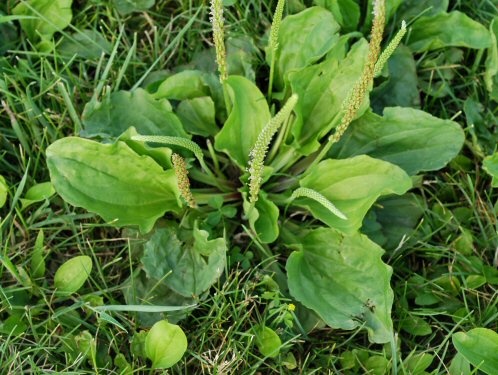
Source: Nutri-Lawn
This weed doesn’t look unsightly as other ones because it grows in a circular arrangement. But you wouldn’t want them to grow in your lawn because they are hard to get rid of. These tough perennials will return even after you mow, trim, or step on them. This is because they have a regenerative crown and a low-growing habit.
Broadleaf plantain tends to grow in damp and compacted soil, so make sure to take care of your lawn before these plants invade it.
Quackgrass
Quackgrass is a type of weed that lawn owners or gardeners have a hard time dealing with. Also known as devil grass or witch grass, this pesky invader is difficult to remove, which could be the reason for its evil-sounding alternative names. Once they grow in your yard, they would quickly spread. If you cut them down, they can easily regenerate from any root left in the soil.
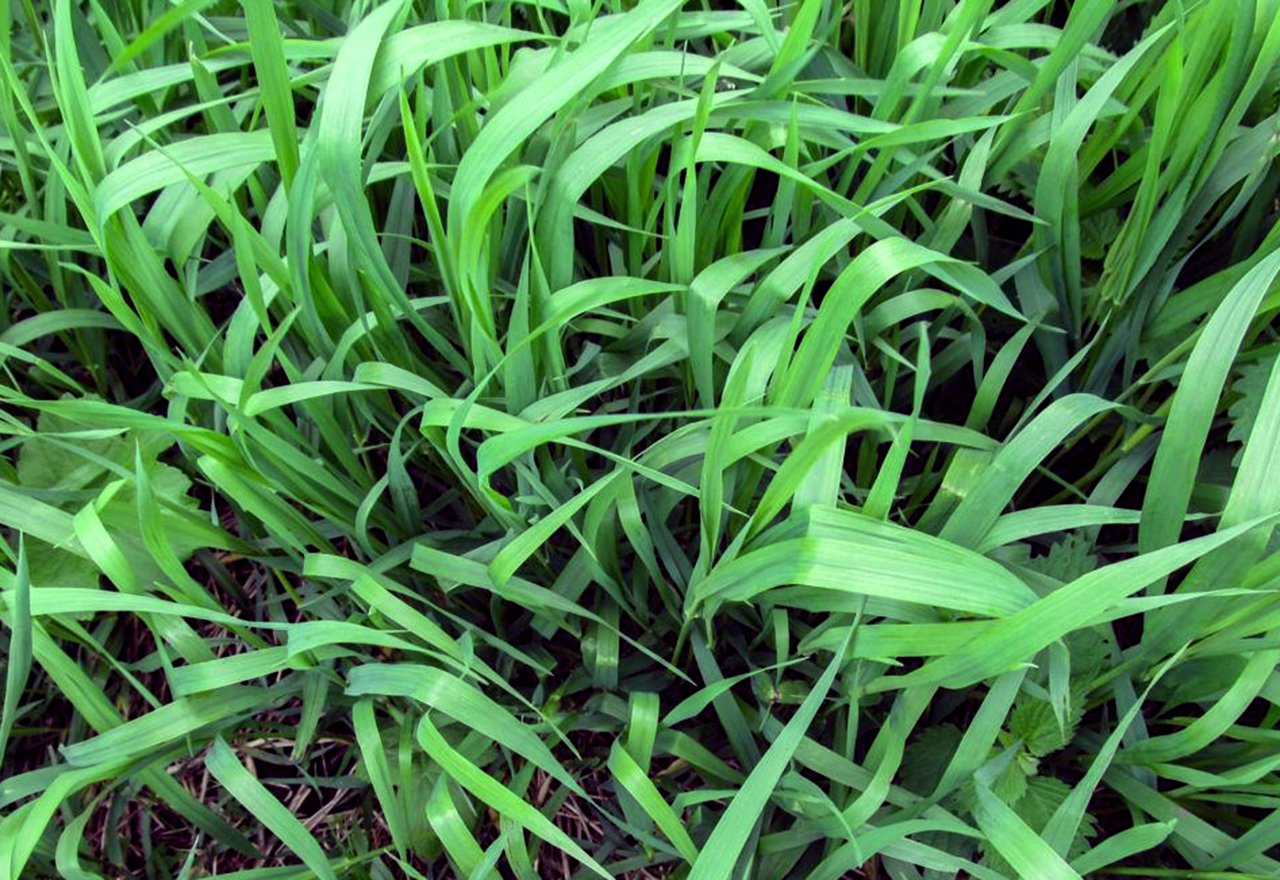
Source: Good Nature
This weed has long and thin stems that grow to a height of 1 to 3 feet. It has narrow and green leaves and is often mistaken for crabgrass. To differentiate it, quackgrass grows upright while crabgrass sprawls low to the ground.
This weed prefers cooler climates, appearing during late spring. They can also grow during the early summer months.
Crabgrass
Quackgrass and crabgrass can be easily mistaken for one another, especially since both can grow in our lawns. Crabgrass thrives in Florida due to the warm climate as well as during hurricane seasons. The hot summer days create bare spots where crabgrass can grow once the rainy days start.

Source: Greenwise
To determine if it is crabgrass growing in your lawn, you should know what they look like in their different stages. As seedlings, this weed has one-fourth inch blades with a light green color. They will then grow and spread on the ground in a star-shaped pattern. Unlike grass, crabgrass will have a thinner width and grows from the center.
It’s important to watch out for early signs because there could already be crabgrass seeds on your lawn. Once they spread, they can last for years in a yard. Even if you get rid of them or they die during the cold season, they would have already dropped their seeds which will grow back the following year.
Spurge
Another weed you need to get rid of as soon as they start sprouting in your lawn is spurge. This is a fast-growing plant that appears during summer months. It spreads quickly and grows low to the ground.

Source: University of Maryland
There are different kinds of spurge but they share common features. It has a central root called the taproot. Spurge extends its stems from this main root. It has rows of leaves growing on the stem, each row having two leaves that grow across or parallel each other. If its leaves are broken, it will release a milky sap that can be irritating when it comes into contact with our eyes and skin.
Dallisgrass
The dallisgrass is a fast-growing plant that sprouts in an enlarging circular clump. This weed will continue to spread even if the center has died, making it a difficult plant to control. They thrive in moist, sandy, or clay soils, and grows two times faster than regular grasses.
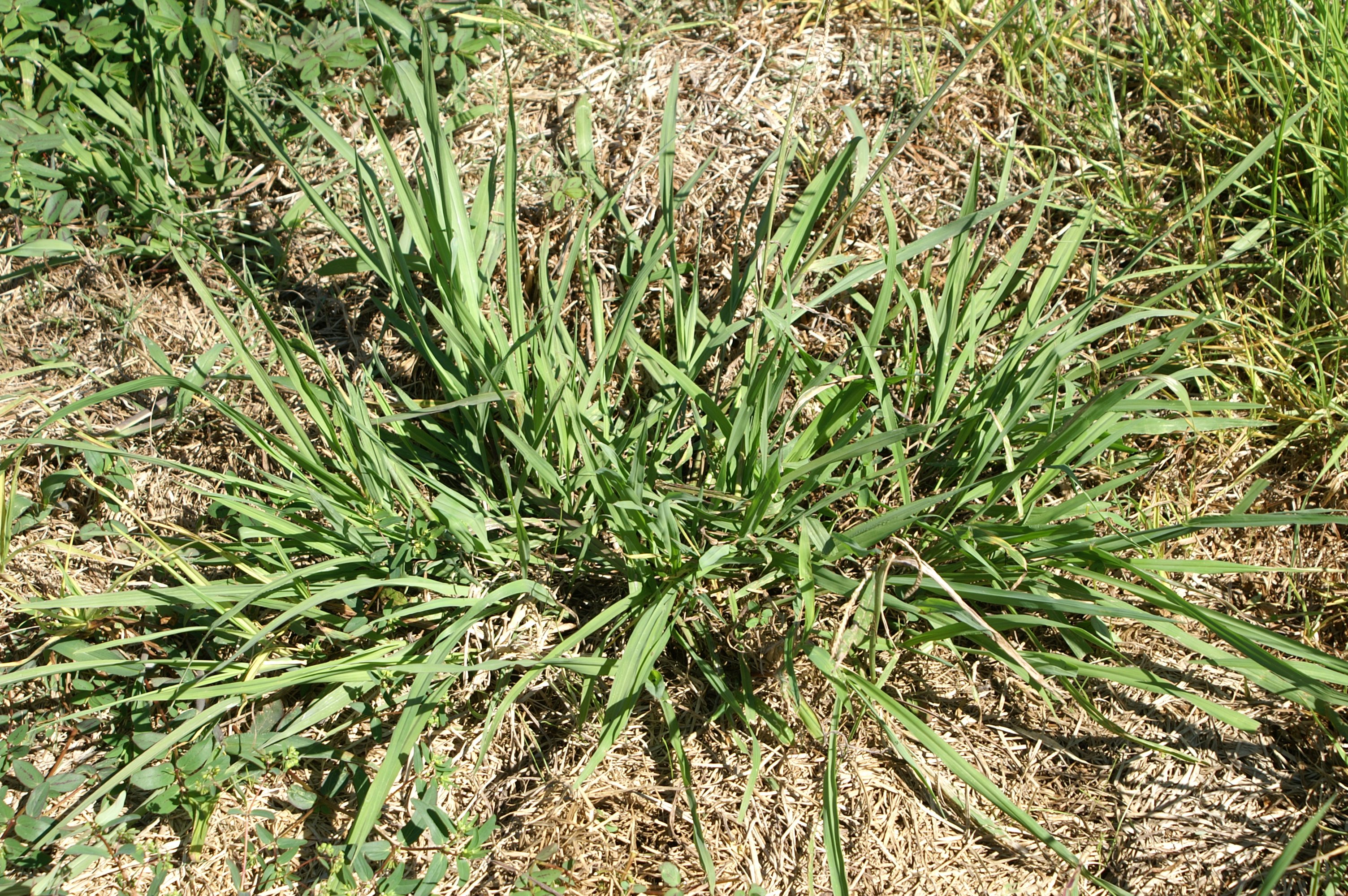
Source: Earthworks
Since they spread faster and produce thick clumps, your lawn would look unsightly if they manage to invade most of the areas. So if you spot clumps in your yard, it could be dallisgrass taking over the turf. To be sure, check if the growing plant has wide leaves with a width of one-fourth to one-half inch. Its blades usually have a light green color and have a coarse texture.
Nutsedge
After heavy rains during the hot season, a surprise that might be waiting for you on your lawn is the nutsedge weed. This plant looks similar to turf grasses, with dark green leaves sticking up. The leaves have a triangular shape, differentiating it from regular grass. It also tends to grow taller than grass, so you’ll notice it after mowing your lawn.

Source: Canopy Lawn Care
It’s challenging to get rid of nutsedge because you can’t just pull it. Its root system comprises of two nuts attached to the roots, and both should be removed to effectively get rid of this weed. If you only detach one nut, it would be almost impossible to remove the second one. Then, the second nut might split and produce more weeds.
Bull Thistle
The bull thistle, or sometimes referred to as cotton thistle, is a biennial weed that grows a rosette in the first year and then blooms the following year. It’s an invasive and pesky weed to have because its firm main stem is thorny and its leaf blades are covered with short sharp prickles. These spikes appear on the darker green and upper side of the leaf blade.
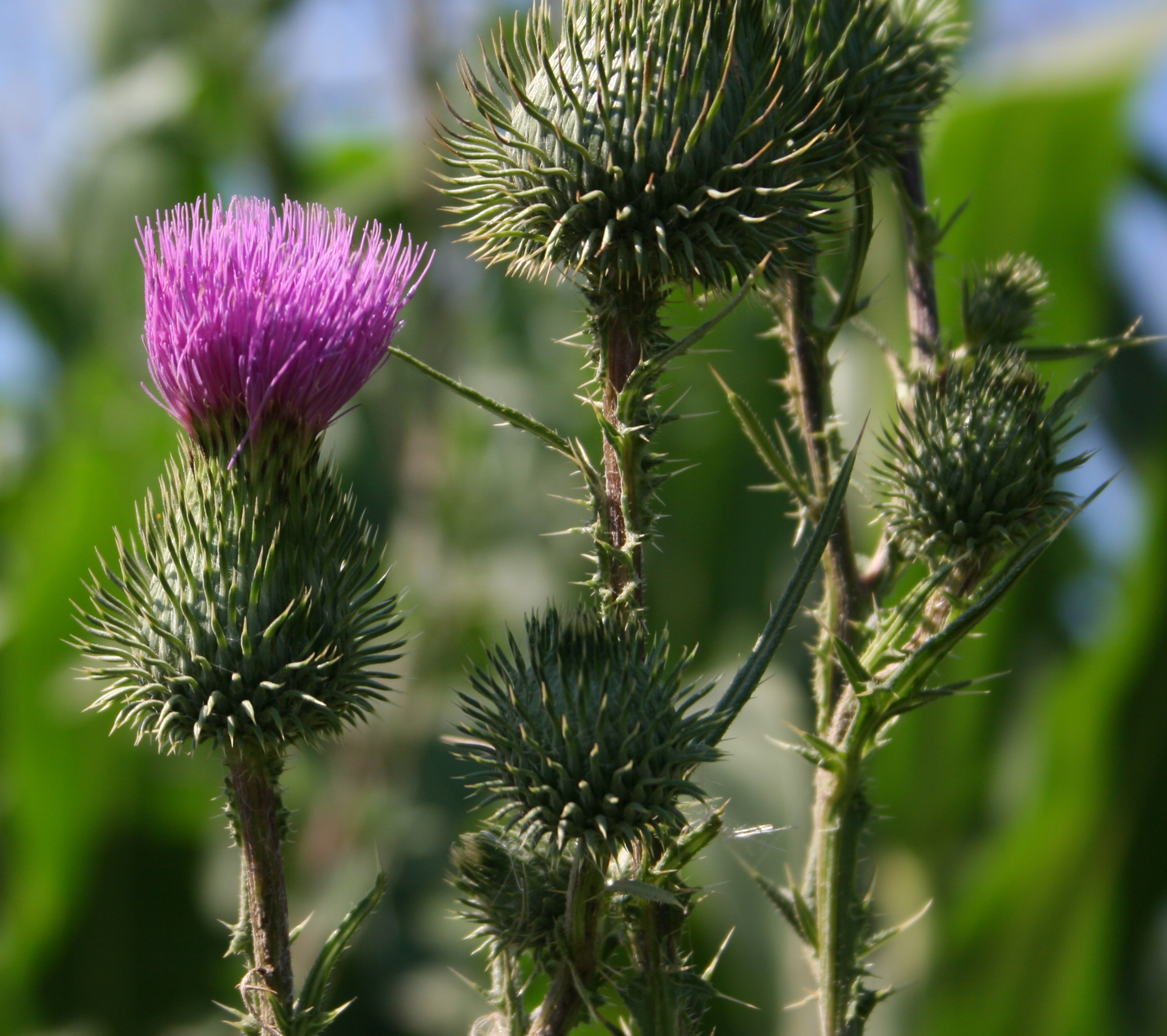
Source: Michigan State University
It’s easy to notice this weed because it can reach 1.5 meters tall, and it grows purple flowers that are spread apart. These spiky flowers can either be solitary or in clusters found at the tip of the branches. Bull thistle thrives in semi-moist soil, but it can also sprout in wet or dry soils. They usually grow near fence lines, by the road, and waste places.
Chickweed
If you think your yard would finally be weed-free during the cooler months - unfortunately, it’s not. While most weeds die during the cold season, chickweed thrives in this weather. They usually sprout during February or around springtime. They dislike the heat and will germinate best in shady areas with moist soil.

Source: University of Wisconsin-Madison
It is an annual weed with smooth and slender stems that can grow up to one foot long. The stems also have rows of tiny hairs on one side and rows of oval-pointed leaves on the other side. Chickweed grows small white flowers with five v-shaped petals.
This weed got its name because chickens love it. That’s why animals should be careful because there are different chickweed look-alikes that are poisonous. Chickweed isn’t poisonous because it does not have milky saps.
Matchweed
Also known as frog fruit, a matchweed is a creeping plant that thrives in moist and disturbed soils. They tend to grow in regularly watered lawns, forming dense mats on the turf.

Source: Pinterest - Spark Interiors
This weed has thin stems that spread in different directions, It has green oval leaves on one side of the stem, while the outer margins are toothed. Matchweed tends to grow low on the ground so it is usually less than 3 inches tall. This plant flowers year-round, except in places with frosty winters. It produces tiny white or light pink flowers in small numbers.
Yellow Woodsorrel
The yellow woodsorrel, or also known as common yellow oxalis, sheep’s clover, sleeping beauty, shamrock, sour grass, and sour trefoil, is a weed that can grow in different conditions but prefers moist soil and shady areas. It tends to sprout by the road or through the cracks in pathways, sidewalks, and other paved areas.
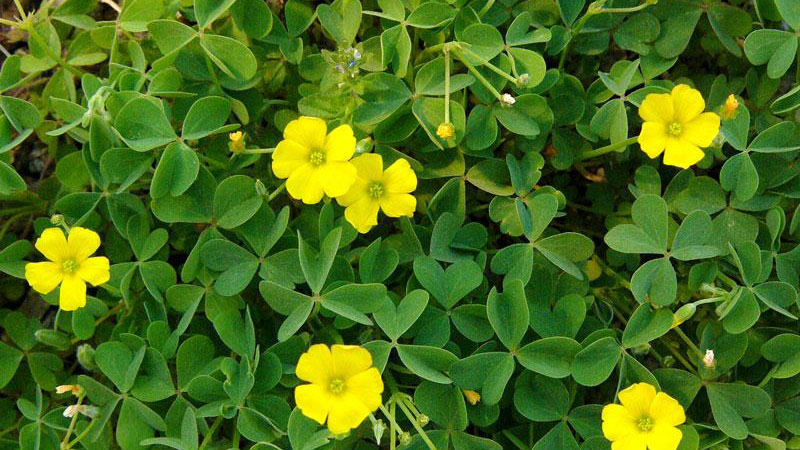
Source: NC State Extension
These pesky invaders have erect stems that grow at a 90-degree angle from the stem, with seed pods also bending upward on the stalks. Yellow woodsorrel can reach a height of 6 to 15 inches if they are not mowed regularly. Its leaves are similar to a cloverleaf, having three heart-like leaflets. This weed also has tiny yellow flowers that have five petals each.
White Clover
White clover is a common weed you’ll find in the northern parts, but not as much in South Florida. It’s a short weed with stems that spread low on the ground. It forms large dense mats, making invaded lawns look unsightly.

Source: My Garden
This plant is part of the pea family, and similar to most members, it also has compound leaves. For the white clover, it has large flower heads with three oval-shaped leaflets. Similar to four-leaf clovers, it is rare to find a white clover with four leaflets.
Florida Pusley
Florida pusley is an annual weed that grows in the summer. They spread low on the ground, forming unsightly thick patches. This weed will smother thin grasses located in poorly-maintained areas.
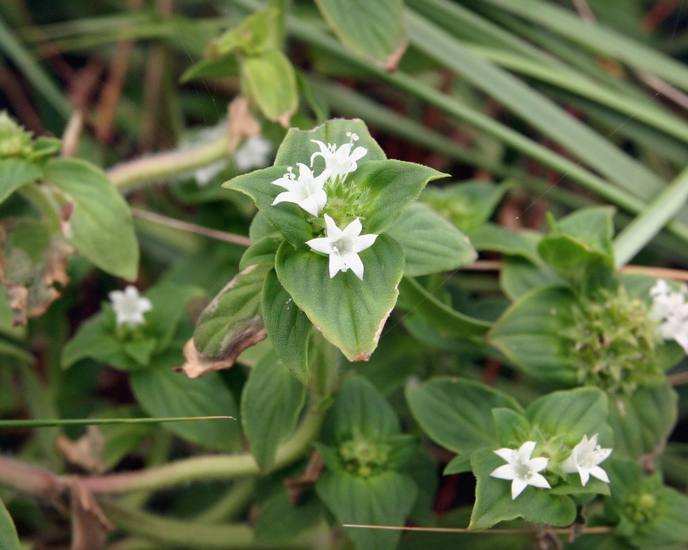
Source: University of Missouri
This pesky invader has hairy stems with hairy leaves growing opposite one another. It has white flowers that grow in clumps at the tip of the stems. It has six petals that form a tube in the middle, producing a star shape.



I have been paying a lawn service for the 3 1/2;years. I have several brown areas and they are telling me the grass is dead and I need to re-sod. Should I hold them responsible for this? My lawn was beautiful when I moved in in 1988.
There’s a lot that could cause brown spots over time such as roof water run off from a new house in the area. I don’t think it is worth holding them responsible, but you should probably get a second opinion / quote. For home service professionals I recommended using Homeadvisor as you’ll typically find service providers that work with HA are more competitive and eager to earn your business. Here is the HomeAdvisor For lawn professionals.